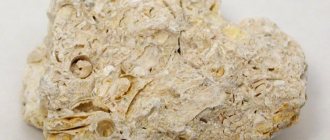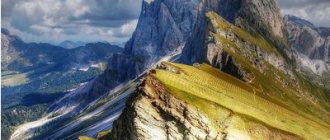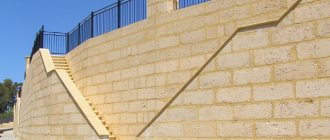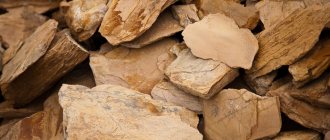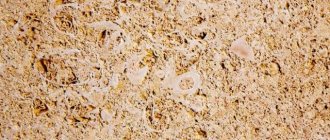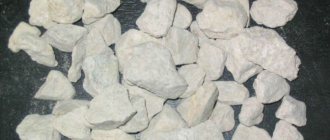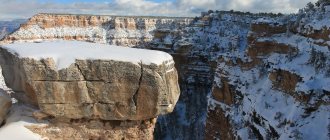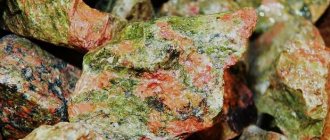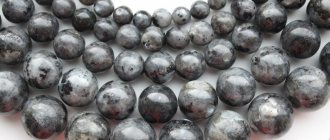Everyone is familiar with limestone: both pliable chalk and durable marble are essentially it. The mineral is unprepossessing in appearance, not rare in nature, and not difficult to process.
And with all this, he managed to become famous in culture and history: ancient Egyptian pyramids, majestic temples and cathedrals, the famous Wall of China, the Moscow Kremlin and other masterpiece buildings were created from it.
There are many signs associated with it; truly miraculous properties are attributed to it. The origin of natural limestone, its varieties, and various uses will be discussed further.
What is
Limestone is a clastic or sedimentary rock.
- It consists of calcium carbonate in the form of calcite crystals of various sizes. Lacks shine.
- The composition of limestone is calcite plus impurities.
- Classic limestone is not particularly durable, light with a grayish, yellowish, beigeish tint. The presence of minerals in the composition ensures the filling of pores, increasing strength. Along the way, the color palette of the sedimentary rock is enriched.
Limestone mineral: properties, formula and description
Natural stone limestone photo
As already said, the lion's share of the mineral's composition is calcium carbonate. The chemical formula of limestone is CaCO3. The properties of this compound allow it to dissolve in water. In nature, this process has global significance: in this way, limestone becomes an important participant in the formation of karst forms of underground relief. Under some conditions, CaCO3 also decomposes into a number of bases, where the most voluminous is carbon dioxide. This reaction also plays a global role in natural life - natural carbonation of mineral waters occurs.
The mineral varieties are characterized by color as follows:
- Traditional colors are light gray, white or cream.
- Colors - pinkish, yellowish, reddish, blue and black.
There is no shine as a specific feature. Density: - /+ 2.6 points. Frost resistance and high thermal insulation.
When the rock is fired, quicklime is formed - one of the oldest building materials.
And when it is dissolved in acetic compounds, an aggressive reaction is obtained with hissing, bubbling and complete dissolution of the mineral.
This, by the way, is the surest way to distinguish natural stone from fake.
Story
The formation of limestone rocks began 240 million years ago, during the Triassic period. This is a Triassic variety. The age of deposits of other species is three times less.
Even primitive people appreciated “ditches” in limestone massifs as shelter.
Since the early Middle Ages, it has been a building stone in Europe and Rus'.
Wall made of limestone
Fragments of the Great Wall of China, the pyramids of Egypt, and the walls of the Kremlin are made from limestone.
Limestone tiles
This facing material is used for finishing various surfaces. External cladding of the building with limestone tiles will improve the appearance of the building and provide it with a long service life. In a country house there are other places where you can use facing tiles: stairs, swimming pools, landscape design elements.
Limestone tiles are also actively used for finishing the internal surfaces of buildings: walls, floors, window sills. Beautiful, well-combined colors of natural materials allow you to create truly unique designs for bar counters, kitchen countertops, arches, and fireplaces.
Where does the breed come from?
Limestones are formed in three ways:
- Biologically. The inhabitants of the seas and oceans extract calcium carbonate from the water - the building material of shells, shells, and skeletons. Example - corals, shell rock.
- Chemogenic. Sedimentary rock is the result of precipitation from aqueous saline solutions during chemical reactions or evaporation of water. Examples are tuffs and marls.
- Mixed type.
The duration of both processes is millions of years. When deposited, the rock creates layers of limestone from tens of centimeters to 4-5 kilometers. The “younger” the sediments, the looser the rock.
A special case of the origin of the rock is metamorphism. In the process of magmatic recrystallization, under the influence of extreme temperatures and pressure, the calcareous rock becomes compacted, hardens, and the grain size becomes smaller. Limestone becomes marble.
How does limestone form?
Living marine organisms, large and small, are very important in the formation of limestone. Developing in the depths of the sea in huge quantities, these marine inhabitants multiply incredibly quickly, but also die quickly.
During their existence, microorganisms manage to extract enough lime from the water in order to equip their body with reliable protection in the form of shells or various shells. Subsequently, the skeletons of dead microorganisms lie on the seabed in entire layers.
Over time, these layers are pressed by the water mass, become strong and eventually turn into stone, the main component of which is calcite. As a result, the amount of calcium carbonate is 60% of the total mass of limestone. The rest consists of carbon dioxide and minor clay impurities. It is the impurities that color limestone in different colors.
Physico-chemical characteristics
Natural limestone is not particularly dense, durable, and easy to cut. The exception is “marbles” and “corals”.
Limestones do not have uniform indicators of basic physical characteristics - density, tensile strength, etc. The value is determined by the origin, structure, age, type of rock. This also applies to material from the same deposit.
Technical Parameters of Limestone
Dolomites and limestones containing magnesium carbonate have greater hardness. They are more difficult to mechanically influence.
Natural limestone is durable and hard. When crushed, it forms an uneven fracture. Doesn't get wet in water. The physical properties of the rock allow it to be used in construction.
Usually the carbonate compound is white, gray in color. But depending on the presence of impurities, the external color and technical characteristics of limestone change. The minerals contained in the formation not only change color, but also affect strength, stability and determine the scope of application.
The carbonaceous substance colors the rock black, the yellow color is determined by the presence of iron hydroxides, and the greenish color is determined by glauconite.
A description of the technical parameters of the material is contained in the deposit passport. The information collected in the document fully reflects the properties of the breed and its compliance with state standards regulated by law.
The structure of limestone allows us to distinguish types of rock. The texture of the mineral formation is uniform, sometimes there are pores and cavities (voids).
Classification, varieties
Limestone, as a rock of sedimentary origin, is a mass of different colors, porosity, and strength. The range is from crumbling chalk to indestructible granite.
Such diversity is created by impurities in the composition of the stone - chemical and organic.
A classification of limestones by type based on basic properties has been developed.
By type of impurities
The presence of a chemical element in the composition creates the color of the stone:
| Stone color | Type of impurity |
| Brown, ocher yellow | Iron |
| Red, brownish | Manganese |
| Gray to black | Organics (petroleum and similar) |
| Greens | Marine vegetation |
| White, grayish | No impurities |
Gray-black limestone is the rarest stone.
By structure, composition
Based on their composition, the following types of rock are distinguished:
- Marbled. Hard, low-porous rock of beige shades.
- Coral. Hard, porous stones, the building materials for which are shells and shells of fossil mollusks. They form colony reefs and atolls.
- Dolomitized. Samples with 3.9-16.8% magnesium oxide.
- Marls. Material containing sulfur.
The intermediate link between limestones and marl is clayey limestones. They are more brittle than shale clays and softer than limestones. Plus a floating ratio of clay and carbonates in the composition of the stone.
By texture, scope of application
The material is distinguished by layered or cracked texture.
According to the scope of use, limestones are classified as fluxing and facing.
Conditions for the formation of carbonate deposits
Limestone is a mineral formation formed as a result of the deposition of skeletal remains of biological organisms and consisting primarily of calcite and partly aragonite. The chemical composition of limestone is close to calcite.
Carbonate material of various origins is common in sedimentary rocks. Similar to the quartz component, the sediments contain fragments of limestone, which is a product of the destruction of existing sediments.
Typical deposited limestone material is found in basal and carbonate conglomerates. Much more common are calcareous sandstones and breccias, consisting of fragments of material that have not been processed as a result of being transported over a distance by wind and water.
This fact allows us to assume their formation in shallow water conditions, in which a number of sections of the seabed rose above the water level and were destroyed as a result of abrasive processes.
It can be assumed that shell limestone was formed under such conditions. It is this type of sedimentary rock that is represented by the entire remains of organisms and their fragments.
We also recommend reading:
The history and curse of the Kohinoor stone The marvelous ametrine stone Characteristics of larimar and its main properties Selection of stones by date of birth
Many organogenic-clastic limestone rocks are represented by the products of sorting of not yet fossilized remains of shallow-water sediments. This type of accumulation forms a group of organogenic formations.
If bioherms (corals that form calcareous formations) immediately form hardened sediments, then the hardening of calcareous sediments is associated with additional chemical transformations of the carbonate part of the sediments.
Sometimes limestones are distinguished by a special spongy structure formed due to dolomitization. Such reef rocks contain oil.
Place of Birth
Limestone is a ubiquitous rock with volumes in the billions of tons.
Why he gained the reputation of being “inexhaustible”:
- Deposits of sedimentary origin are found on all continents except Antarctica and Australia.
- The Alps, Pyrenees, and Crimean Mountains are made of limestone.
- The largest deposit was discovered in eastern Ukraine.
The lion's share of Russian limestone deposits is concentrated in the European part: sea waves splashed here millions of years ago.
The stone is mined from Arkhangelsk to the Krasnodar Territory. The surrounding areas of Belgorod, Tula, Moscow, St. Petersburg, Vologda, Voronezh are rich in limestone.
Limestone quarry in Gornozavodsk
The youngest is the Zhdanovsky mine in the Orenburg region.
The stone is found in the Urals, the Caucasus, and Siberia, but these are isolated cases.
Limestone rocks in the Che-Chkysh tract; Katun Valley, Altai
The concept of limestone, its chemical formula, what it looks like in the photo
Limestone is a sedimentary mineral of organic or chemogenic origin. It is characterized by a maximum content of calcium carbonate (CaCO3), which is presented in the form of calcite crystals of different sizes. If you examine the material at high magnification under a microscope, you can find impurities of phosphates, silicon, sand and clay particles, and the remains of shells of ancient microorganisms. The chemical formula of limestone, which contains dolomite, is CaMg(CO3)2. The admixture makes the material strong and dense.
The photo shows that the mineral can look different. The rock composed of shells (shell rock) has a fine-grained structure, while its relative chalk has a fine-grained structure. Chalk, marble, stones with inclusions of round shells (nummulitic limestones) are all varieties of limestone. What color is the mineral? The picture shows that it is naturally white. Impurities and their combinations give the mineral unique shades.
Production
As a rule, limestone lies shallow.
Therefore, stone extraction is carried out not by the mine, but by the explosion-stripping method:
- The surface layer of soil is removed.
- Shafts are drilled in the massif, into which explosives and TNT are placed.
- The material is undermined.
- The resulting debris is loaded into dump trucks and transported to the crushing and processing plant.
- Here the rock is crushed into fractions and sent to customers.
- Substandard material – material smaller than a centimeter – is returned to the quarry.
In thin areas, natural stone is cut into fragments of the required dimensions and transported to the factory.
Europeans use the “loosening plus loading” technology. The use of explosives is not intended.
Names used for slaked lime
Due to the fairly wide distribution of slaked lime in different regions of the world, as well as in different fields of activity, it was called differently. Among the most popular and common names, it is worth highlighting the following:
- calcium hydroxide.
This term reflects the formula of the substance, since it consists of Calcium and Hydroxide. It is used in scientific and technical literature.
Today, this term has replaced other names in many areas.
Calcium hydroxide
- slaked lime. Here's how to use it. This name comes from the fact that the substance is produced by extinguishing (that is, adding water).
Slaked lime
- lime milk.
This is lime, which occurs as a result of too much slaked lime when combined with aqueous solutions and directly with water.
It looks a little like milk in color.
Lime milk
- lime water. This term refers to the translucent solution that is obtained after filtration.
Lime water
- fluff lime or lump lime.
Such material is obtained in cases where the substance is not used for a long time.
During this period, it begins to absorb carbon dioxide from the environment, thereby hardening.
Lime fluff
There are also a number of other names and terms that are commonly used in relation to slaked lime. All of them have been used in one way or another over a certain period, or are currently used.
Where is it used?
The utilitarian characteristics of limestone - strength, polishability, grinding, and other types of processing - have determined the demand for the stone.
Construction
The main consumers of the products are builders, architectural and landscape designers:
- Natural stone is the source for the production of crushed stone, chalk, cement, concrete, and other mixtures.
- Limestone is a medium-strength rock, therefore it is rarely used as a basis for walls and ceilings. High-quality, viscous material – quicklime. It is obtained by firing natural stone.
- The slabs cover the walls of buildings (inside and outside), floors, flights of stairs, and fireplaces.
- Paths are being paved in parks, around country houses and country houses.
- Pastel stones are an aesthetic decorative material (balusters, cornices, stucco). Travertine (lime tuff) is good.
A variety of types of building stone makes it easier to choose a brand for a specific purpose.
Use of Limestone in construction
Industry
Manufacturers use limestone for their needs:
- For metallurgists, it is a flux that facilitates the smelting of alloys.
- For glaziers - a component of heat-resistant glass.
- Without it, it is impossible to produce rubber, soda, varnishes, paints, and other products in the chemical segment.
- Farmers purchase fertilizers and livestock feed based on or with limestone additives. They neutralize the acidity of the soil.
- This is a raw material for the production of tooth powder, paper, colored chalk, and soap making.
In the food industry, stone is a filter for water purification and sugar production.
Other areas
- The best material goes to jewelers and collectors.
- Jewelers make beads, inserts for rings, brooches, and rings from translucent stones in pastel shades. Framed with silver, jewelry alloy, cupronickel.
- Collectors of mineralogical collections strive to create a composition from stones of all textures, colors, and deposits. The object of the hunt is samples with the remains of prehistoric flora and fauna in the rock mass or imprints.
Dagestan stone, Limestone
Restrictions
The use of limestone as a base for building walls is limited by its properties:
- Absorbs water, gradually dissolving.
- When interacting with acids, it releases carbon dioxide.
As a result of precipitation, groundwater with acidic compounds decomposes the limestone massif. Sometimes very quickly. And voids are created under buildings. Therefore, slabs or blocks are impregnated with a water-repellent composition.
Applications of limestone stone
Processed limestone stone
Over the entire period of its existence, people have deeply understood the properties of this natural gift and learned to use it with maximum benefit.
Here are the main areas of human activity where limestone is an important material:
- Construction. Varieties of stone are useful here in everything: in the construction of stable high-rise buildings, in cladding facades and for paving surfaces.
- Landscape design and architecture. Ease of processing and decorative properties are highly valued in these areas, especially when it comes to layered types of mineral with a characteristic weathering pattern.
- Production of finishing materials. Here the emphasis is not on decorativeness, but on the organic origin of the stone.
- Cretaceous rocks are used to make crayons, tooth powders, and the production of expensive high-quality paper.
- Cable production cannot proceed without coating welding electrodes with limestone compounds.
- The printing industry widely uses lithographic limestone to create highly artistic engravings.
- Jewelry making. Translucent samples of pastel colors are appreciated. The best design and decorative combinations are obtained with silver and cupronickel frames.
Treatment potential
Organic stones are respected by healers. It is a hypoallergenic with universal healing effects. Flowers have their own “specialization”:
- Yellow. Adjusts the functioning of the gastrointestinal tract.
- Blue. Lowers blood pressure.
- Pink, red. Normalizes mental health and sleep. Used to solve blood problems.
Buddhists use yellow stone as an object of meditation.
The stone, regardless of color, is an antiseptic that suppresses infections anywhere in the body.
There are only a few contraindications:
- Blue stone requires caution from hypotensive people.
- Inhalation of limestone dust depresses the respiratory system. This is a problem for workers at ore processing plants.
Limestone treatment involves placing a stone on the sore spot. You can hold it in your hands or drink the water in which the washed stones have lain overnight.
Limestone stone: beneficial properties
Lithotherapists, basing their recommendations on the experience of many generations, advise using the mineral as a remedy with the following qualities:
- absorbent;
- hypoallergenic;
- antiseptic.
For any illness, it is considered beneficial to drink water that has been purified with calcite.
It is also believed that limestone stones purify and disinfect indoor air.
Limestone can only cause harm to those who mine it - inhaling mineral dust and its settling in the lungs does not have the best effect on health.
There is a whole gradation of the healing properties of limestone based on color:
- Reddish calcite. Treats nervous feelings and blood diseases.
- Yellowish limestone. For meditation and regulation of digestion.
- Pink varieties. Nervous disorders, healthy sleep.
- Blue limestone. Reduced pressure.
The therapeutic effect is achieved through contact with the stone: it is applied to the diseased area.
You can simply hold it in your hands during individual attacks and manifestations of the disease.
Magical influence
The magical effect of limestone copies calcite:
- Activation, strengthening of intuition.
- Protection from spontaneous actions, decisions and the problems they cause.
- The ability to analyze in advance the consequences of decisions made.
The stone is shown as a talisman for sybarites, neurotics, sloths, and angry natures.
Limestone is an assistant to lovers and creative people. The former will achieve the favor of their loved one, the latter will feel a surge of inspiration.
Limestone stone: magical properties and zodiac signs
In magic, a legend is associated with the stone that it develops the extrasensory abilities of every person and opens the way to clairvoyance.
This is a talisman against laziness and for creative imagination. Astrologers have included limestone in the list of universal stones suitable for most zodiac signs.
Only Scorpios are excluded - among them there are most people prone to the occult and black magic. And limestone, in its aura, is a conductor of light energy and high spiritual vibrations. This contradicts the mystical bias of Scorpios, and the limestone talisman is “not friendly” with the strong-willed and aggressive sign.
As for the rest, the mineral willingly shares its invigorating and inspiring properties and helps the owner see the outcome of the situation.
Physico-mechanical properties of limestone:
| Indicator name | Meaning |
| Bulk density, tons/m3 | from 0.8 (for shell rocks and travertine) to 2.8 (for crystalline limestones) |
| Mohs hardness | 3 |
| Water absorption,% | 0.1 to 2.1 |
| Dry compressive strength, MPa | from 0.4 (for shell rocks) to 300 (for crystalline limestones) |
| Porosity, % | from 0.5 to 35 |
| Strength reduction coefficient when dense limestones are saturated with water | 0,65 – 0,85 |
| Strength reduction coefficient when soft limestones are saturated with water | 0,50 – 0,70 |
| Decomposition temperature, оС | 800 – 900 |
| Melting point, oC | 1242 |
| Frost resistance for crystalline limestones, cycles | 300 – 400 |
Stone processing company PetroMramor
>
home
“I saw an angel in a piece of marble and cut the stone until I freed it.” “I only feel good when I have a chisel in my hand.”
Michelangelo Buonarroti
The stone processing company was formed by a group of professionals in the field of processing natural stone for the production of building products and has been successfully operating on the Russian market of natural stone products since January 2002.
has the material and technical base and a full range of technological equipment for the production of natural stone products.
Two stone processing plants of the PetroMramor Company produce more than 8,000 sq.m.
high-quality granite and marble products of varying complexity.
Over the years, the most demanding and demanding customers have become our regular clients and trust us to carry out the most complex and important work related to the processing of natural stone. pricing policy is presented in the “Cost and Prices” section. In particular, prices for granite slabs 20 mm thick with a polished texture vary from 2,700 rubles to 3,500 rubles. The price of slabs with a heat-treated texture of the same thickness ranges from 2,500 rubles to 3,500. Accordingly, slabs with a thickness of 30 mm cost from 3,000 rubles to 4,200 rubles for a polished texture, and heat-treated ones cost from 3,200 rubles to 4,200 rubles.
The company's products adorn the Trinity Cathedral of the Solovetsky Monastery,
the Valaam Spaso-Preobrazhensky Monastery
, the Old Provence wine estate in Gelendzhik, the Notary Chamber of St. Petersburg, Monuments to Grand Duke Mikhail Nikolaevich and M.T.
Kalashnikov in the Military Historical Artillery Museum of St. Petersburg, the monumental group of the monument to Alexander I in the Alexander Garden of the Moscow Kremlin, the Lakhta Center public and business complex
, the Residence of the President of the Russian Federation in Sochi, the Moscow River Station, stations of the St. Petersburg and Moscow metro .
The company is equipped with diamond wire saws and circular machines for cutting granite and marble blocks, two polishing conveyors, texture processing equipment and CNC milling equipment.
This site produces slabs, facing slabs, paving slabs, sawn and sawn-split paving stones of various thicknesses and textures, steps, borders and other products from granite deposits in Karelia, Finland, Kazakhstan, the Urals and the Leningrad region: Kamennogorsk, Letnerechensky, Vozrozhdenie, Dymovsky
, Baltiyskoye, Elizovsky, Ladoga, Kashina Gora, Drugoretskoye, Ala-Noskua, Mansurovsky, Gabbro, Kuru Gray, Baltic Brown, Balmoral Red,
Kurtinsky
, Zheltau and other granites.
Products are manufactured from granite and marble from Russian and foreign deposits (Brazil, Italy, Spain, China, India, Egypt, Ukraine).
Processing is carried out on modern CNC machining centers using manual processing elements. Contact us and you will be pleasantly surprised by the low prices for the production of memorial groups
, bas-reliefs, columns and other products from granite, marble and limestone!
All
granite and marble products produced by the PetroMramor Company comply with GOST requirements.
Particular attention is paid to the quality of products and packaging, ensuring safe transportation of products from the stone processing plant to the construction site.
Polishing of products is carried out using classical technology for processing natural stone with diamond and abrasive tools without the use of chemicals and polishing compounds. The technology used is the most labor-intensive, but ensures that the natural polish of natural stone is preserved for many years. For complex and expensive products, especially those used outdoors, maintaining the polish for many years and durability are most important.
The PetroMramor company offers to buy finished products made of granite, marble, limestone and travertine at wholesale prices: granite facing slabs 20 mm and 30 mm thick with a polished, heat-treated, sawn, honed or polished surface, including for ventilated facades, heat-treated paving slabs or bush hammered (spot processing),
sawn, chipped and sawn-split granite paving stones,
water receiving bowls and trays, side stones (curbs), tactile granite slabs, small architectural forms of granite and marble, columns, fountains, monuments and pedestals,
memorials and monuments
, kitchen countertops made of granite and marble, window sills and ebbs made of marble and granite, bas-reliefs and high reliefs, mosaic panels made of marble, fireplaces made of marble and granite, stairs and balustrades made of granite and marble, balusters, steps, risers, railings, slabs from self-made granite from granites from Russia, Finland and Kazakhstan, imported slabs from marble and granite, “wild stone” and slabs of “rock” texture; massive (solid) granite steps, finished granite steps, granite surrounds, substandard granite slabs; blanks for monuments and much more.
To learn more about our capabilities, we invite you to visit our office and showroom at the address: St. Petersburg, Line 14-ya V.O., building 7, letter A, Preobrazhensky Business Center.
You can get directions on the Contacts page. Find information about the main types of stone products, their features, prices and delivery options in the sections:
Stone prices
Granite deposits
Production
Selling blocks
Stone products
